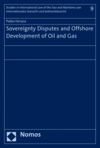Zusammenfassung
Maritime Grenzstreitigkeiten haben seit der Unterzeichnung der UN-Charta sukzessive zugenommen. Diese haben nicht selten ihren Ursprung im staatlichen Zugang zu natürlichen Ressourcen, gerade bei der Grenzüberschneidung von Schürfgebieten.
Verschiedene Wissenschaftler und Kommissionen haben sich dem Problem bereits angenommen, meist jedoch ohne Berücksichtigung spezifischer lokaler und kontextueller Besonderheiten. Diese Lücke schließt die vorliegende Arbeit, indem sie zunächst die Gestaltung bilateraler Zusammenarbeit in unterschiedlichen Fällen bei der Offshore-Förderung von Öl und Gas skizziert. Auf dieser Basis wird gezeigt, wie und wodurch ein unterschiedliches Vertragsdesign nicht nur unterschiedliche Ergebnisse zeitigt, sondern auch unterschiedliche Dynamiken und Entwicklungen von Kooperation auslösen kann. Mittels einer Reihe von Fallbeispielen werden Parameter herausgearbeitet, um Rückschlüsse auf allgemeine Entwicklungen und Wirkungen von Institutionen aufzuzeigen.
Abstract
Since the signature of UN Charter in 1945, the evolution of state boundary delimitation has been substantial, although a relatively large number of specifically maritime boundary disputes globally appear more or less intractable. These disputes are in no small measure driven by concerns on the part of the states involved to secure access to natural resources – perhaps especially hydrocarbons – which they know or at least suspect are located within the area of the overlapping claims.
The International Law Commission as well as international scholars (v.g. Lagoni, Onorato, Blake, Pratt, Schofield, Nordquist, Benvenisti, etc.) have studied different forms of cooperation regimes and extrapolated their applicability from one region to the other, sometimes without taking into account diversity and uniqueness of contextual realities. This work boards some of the analytical predicaments exposed previously, with an unprecedented methodological twist: it is first oriented to describe and then explain variations in the design of bilateral cooperation regimes between states with common offshore oil and gas deposits; secondly, it analyses whether variation in design of cooperation institutions leads to variation in the outcomes, dynamics, and evolution of that cooperation. In order to proceed with the proposed task, a two-step analytical matrix is brought upon a number of study-cases, with individual and general conclusions. Altogether, methodology can be described analogically, using the language of complex adaptive systems: a range of complex cases are brought together, general parameters are provided for them, and they are watched to see what kind of intellectual “emergent property” comes out as plausible conclusion about the evolution and effect of institutions across situations.
- 169–174 7 Conclusions 169–174
- 177–188 BIBLIOGRAPHY 177–188

